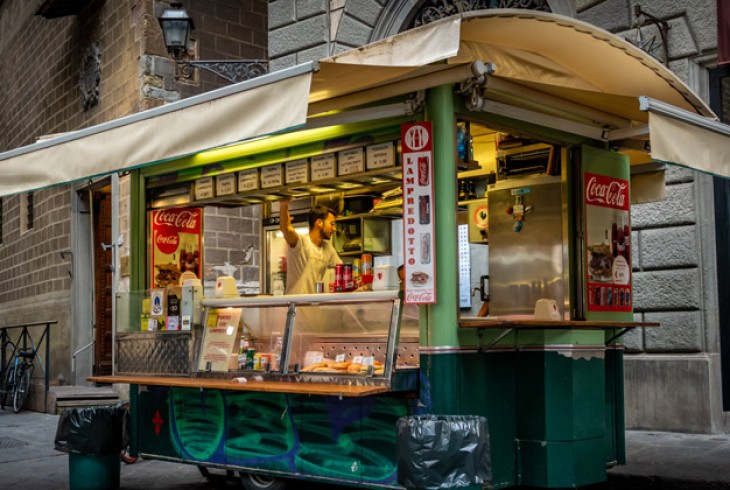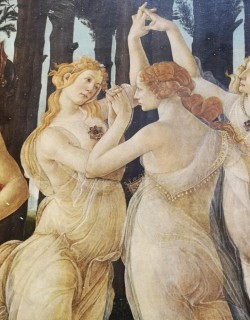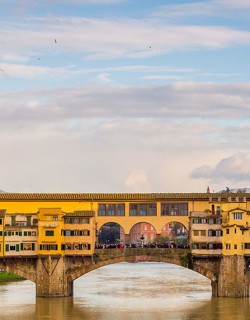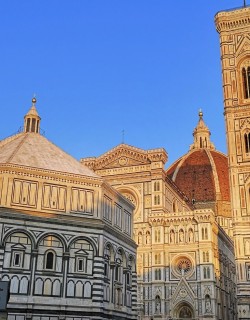The way to a city’s heart, as the saying doesn’t quite go, is through its stomach. Florence is justifiably famous as one of the world’s greatest treasure troves of Renaissance art, where incredible museums and churches offer a unique window into the lost splendour of a cultural golden age. But if you want to discover how the city lives right now and what makes its people tick, you won’t find any answers rubbing shoulders with Botticelli in the Uffizi or admiring Michelangelo’s David in the Academia.
No, to get to Florence’s beating heart you’ve got to follow the streams of locals as they make their way in hungry hoards to street-food vendors all across the city, ready to take part in an age-old daily ritual that’s equal parts history, tradition and sheer culinary magic - all concealed in the humble disguise of a simple sandwich. If the phrase street food uneasily brings to mind an achingly on-trend brand of gourmet hipsterism, fear not: you won’t find any avant-garde fusion cuisine served from vintage VW buses in ultra-traditional Florence. Instead prepare yourself for a world of rough-and-ready street-corner kiosks known as chioschi, staffed by gruff men who’ve been feeding generations of Florentines delicious but no-frills fare their entire lives.
As an added bonus, if you’ve mistimed things and find yourself struck by hunger pangs in the hours between lunch and dinner, usually a gastronomic no-go zone in Italy, these always-available street-food staples can be a lifesaver. So pull up a wooden stool, flop onto the kerb or just prop yourself up lazily against the side of the chiosco and discover the Florentine street-food classics you need to try and where to sample them at their best - in the shadow of looming Renaissance palaces, naturally, surrounded by chattering locals.
1. Panino con il Lampredotto
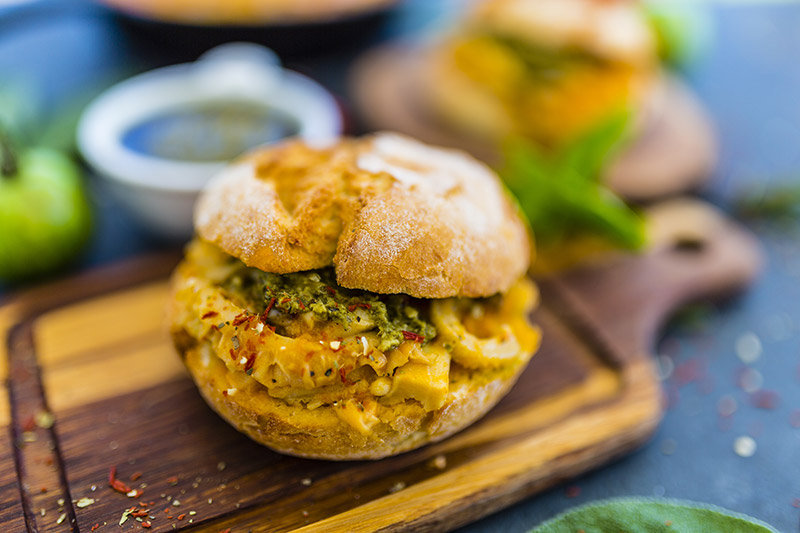
The undisputed jewel in the crown of Florence’s street-food scene is the humble panino con il lampredotto, and if you try just one thing in Florence this should be it. A variant of tripe found only in the city of the Medici, lampredotto might seem a bite too far for the unadventurous - it’s made exclusively from the abomasum, or a cow’s fourth and final stomach, simmered for hours and hours in broth with tomatoes, onions, celery and parsley until meltingly tender. When you place your order the still-simmering stomach is expertly sliced and stuffed into a golden-baked roll known as a semella, made lusciously soft and savoury by swiftly dipping the top half into the cooking broth. The lot is spiked with chilli oil, salt, pepper and salsa verde – a fresh combination of parsley, basil, anchovies and olive oil. Don’t let squeamishness get the better of you and take our word for it – it’s absolutely delicious!
Lampredotto is a classic example of cucina povera, or ‘poor cuisine’ made from inexpensive ingredients. As in Rome, where offal traditionally forms a staple of the city’s popular gastronomy because of its inexpensiveness, so too in Florence the leftover innards of the butcher’s trade (the paradoxical quinto quarto, or fifth quarter of the animal) provided vital sustenance for a hungry and impoverished populace. Pungent boiled tripe was being sold along the banks of the Arno as far back as the 1400s, and in the 19th-century lampredotto was dispensed through the city’s alleys and piazzas from brightly painted wooden carts. The families of the purveyors of these heavenly sandwiches today, known as lampredottai or trippai, have often been in the game for centuries, with their jealously guarded recipes passed down from one generation to the next.
Where to try it
If you are wandering through central Florence and hunger hits, make your way to the Piazza del Mercato Nuovo, a mere 100 yards from Piazza della Signoria, and join the inevitable queue that’s formed in front of Il Trippaio del Porcellino. The stand takes its name from a famous bronze statue of a boar in the centre of the square – according to a long-standing legend, visitors who rub his snout are sure to return to Florence. When you taste proprietor Orazio Nencioni’s incomparable lampredotto, you’ll go running to the statue to ensure your own return visit. A panino costs €4; pair with a glass of wine for just a euro more. Another guarantee in the centre is Da’ Vinattieri, literally a hole in the wall in the historic cobbled alleys just west of the Bargello. If you are near the covered San Ambrogio market meanwhile, head for Sergio Pollini Lampredotto. Or if you’re south of the river, make tracks for Il Trippaio di San Frediano, a 5-minute walk from the Brancacci chapel and Santo Spirito.
2. Panino con Bollito
So you’ve bravely sampled lampredotto, but in your heart of hearts know that tripe isn’t your thing? Fear not, because the Florentine penchant for rich and meaty sandwiches still has you covered. When Netflix food sensation Samin Nosrat (of SALT, FAT, ACID, HEAT fame) many years ago travelled to Europe in search of transformational culinary experiences, her colleagues at the Berkeley restaurant Chez Panisse insisted that she place an unassuming market stall in Florence’s Mercato Centrale right at the top of her list. The object of their fevered food fantasies? The panino con bollito from Nerbone. As with lampredotto, the meat – in this case beef brisket - simmers (but never, ironically, actually boils) for hours. And like lampredotto, it must rigorously be paired with salsa verde and chilli, served in a roll dipped in the cooking juices. An initially sceptical Nosrat’s first bite experience is a common reaction for first-time visitors to Nerbone – ‘I took a bite and swooned. Suddenly, I understood.’ This is a sandwich sacrilicious elevated to the rarefied realm of religious experience.
Where to try it
Your first port of call has to be Nerbone on the ground floor (stall #292) of Florence’s Mercato Centrale in the San Lorenzo district, the ne plus ultra of the panino-maker’s art and a Florentine institution since 1872. The cost is no longer the 25 lire cent of that distant time, but at a mere €4 in 2019 it’s still a steal. Washing it down with a €1 glass of local red is also obligatory here. If you arrive at the market to find the stall cleared out or their shutters down (Nerbone is only open until 2PM), fear not. Just outside the entrance to the Mercato you’ll find a chiosco known as Lupen e Margo. It’s popular with tourists, but don’t hold that against it – the bollito served up by the charming Beatrice Trambusti is up there with the very best.
Discover the myriad marvels of the Renaissance’s first city with Through Eternity’s private or small group walking tours of Florence.
3. Schiacciata
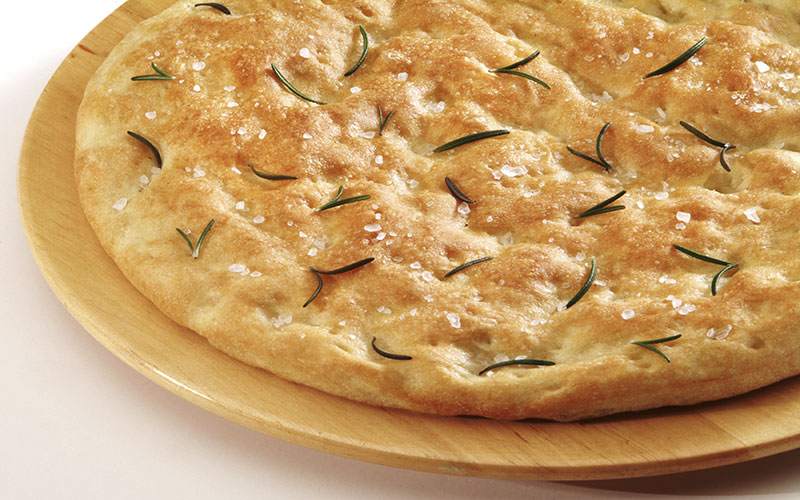
If you’ve sampled so many panini with lampredotto or bollito that you begin hallucinating or mooing, it might be time to give the high octane meat sandwiches a rest. Luckily for you, this is where the schiacciata comes in. Schiacciata in Italian simply means squashed or pressed flat, and this is a sandwich made from a particular kind of flattened roll infused with oil and salt during the baking process by the baker’s fingers in a manner very similar to the better known focaccia. Florentines are extremely demanding when it comes to their schiacciata – they have to be just oily and salty enough without being overbearing, possess just the right amount of crispiness, and ideally be cooked in a wood-fired oven. Traditionally eaten on their own, these days they’re more often split open and stuffed with an almost endless variety of delicious fillings, the porous bread cheerily absorbing any and all flavours thrown its way by expert hands.
Where to try it
The schiacciata shops dotting the city centre are almost unbelievably popular with Florentine youth, and a queue of 50 or more people waiting to be served at All’antico Vinaio, practically in the shadow of the Uffizi, is a common sight at any time of day or night. But don’t let that put you off - the line moves quickly, and their €5 sandwiches are amongst the best in Italy. Try La Dante, a worthy culinary tribute to the city’s greatest son filled with capocollo (a typical Italian cured meat made from pig’s neck), stracchino cheese, fresh rocket and truffle cream. Every bit as good is nearby I Fratellini, another hole in the wall in continuous operation since 1875 and where fabulous and unusual combinations such as herring and salsa verde or raw Tuscan sausage and eggplant will set you back just €4 - pair with a good glass of Chianti to sip whilst you perch on the street outside for another €1.50.
4. Crostini
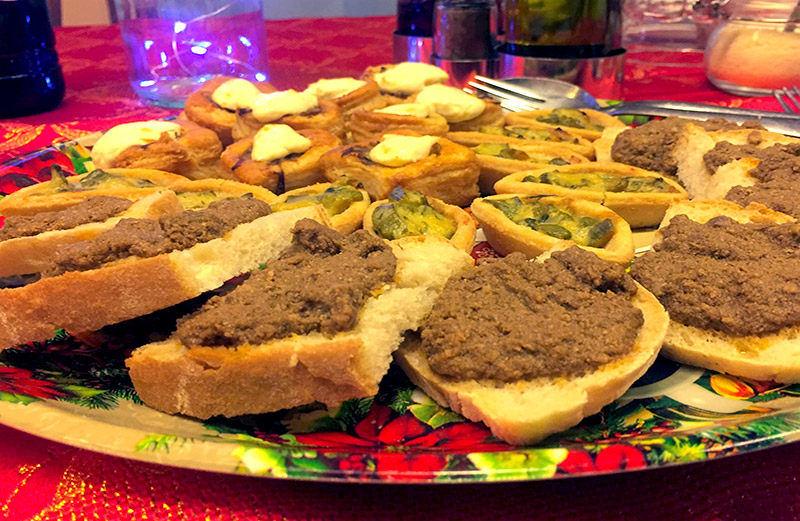
If there’s one Florentine experience that defines the city more than any other, it’s the feeling of intense satisfaction and relaxation that washes over you as you settle down for an early evening glass of wine to toast the close of another day and the dawn of another evening’s possibilities, often quaffed perched on a rickety wooden stool on the cobbles outside a traditional enoteca. There’s no shortage of high-end wine bars in the city boasting a laundry list of Tuscan super reds and gourmet nibbles, but sometimes you’re better off plumping for a ‘gottino’ – that is, a small glass of wine of usually relatively humble vintage that’s light on the wallet. This being Florence, you’re going to want something to munch on as you sip, and the go-to option here are crostini – small bite-sized morsels of toasted bread topped with a dazzling array of meats, cheeses, vegetables and spreads. If you want to garner some authenticity points from the barman then make sure you include at least a couple of fegatini on your plate – a heady and traditionally Florentine paté of chicken liver, capers, anchovies, butter and white wine.
Where to try it
Our favourite place in Florence for a glass of red and a plate of crostini is La Fiaschetteria Nuvoli. Just 100 yards from the Duomo, time seems to stand still in this old-school wine-bar frequented by more locals than tourists and where the prices are straight from the 1980s – a seriously decent glass of Chianti will set you back just €3. Add a couple of crostini al fegatino for €2 more and you’ve got a perfect pre-dinner aperitivo for a fiver, practically in the shadow of Brunelleschi’s great Cathedral dome. If you’re looking for something a little more refined, then your best bet is to head south of the river to bustling Oltrarno. Here you’ll find two of the city’s best enoteche, both of whom serve legendary crostini. The first is chic Le Volpi e l’Uva on piazza dei Rossi, hidden away down an alley just a few metres from the Ponte Vecchio. The second is Il Santino a little further to the west on Via Santo Spirito, where the crostino has been elevated to the realm of high art by chef Luca Marin.
Might Interest You:
-> City of Flowers, City of Lovers: The Most Romantic Things to Do in Florence
